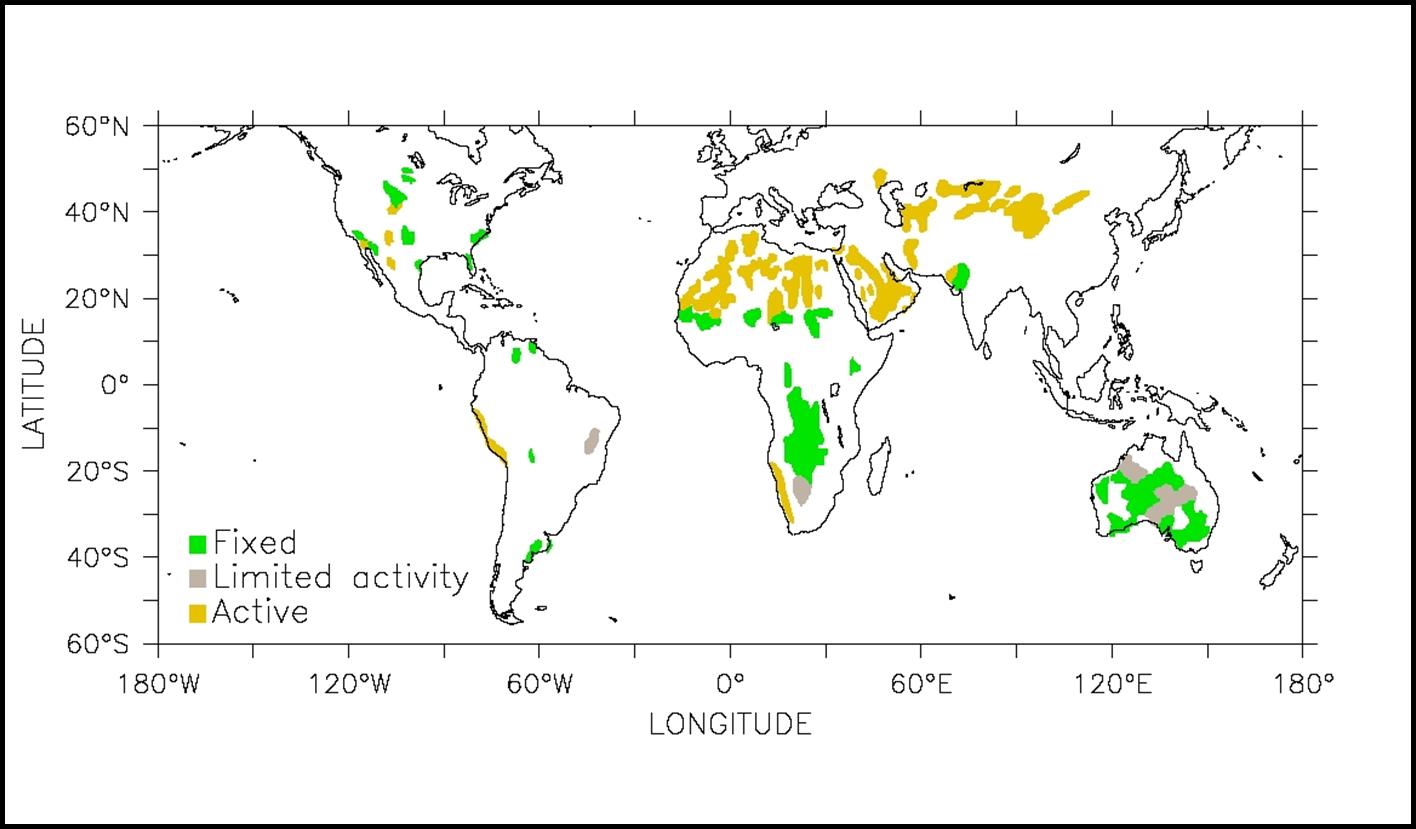At first glance, it seems that the relationship between climate and dune stability can be easily explained. In arid regions with low precipitation, there is little or no vegetation and wind power blows piles of free-flowing sand into dunes, whose shape and movement depend on the speed and directions of local winds. This is the situation in the Sahara desert and the great Mojave Desert in California. In more humid climates with milder temperatures, precipitation facilitates the growth of plants on the sandy soil, where roots and wind-breaking leaves tend to stabilize formerly mobile dunes. This situation is also well known throughout the world, including much of the Great Plains in the U.S. or the northern segment of Israel’s Negev desert, where rainfall averages about 100 mm per year and winds are less powerful.

The global distribution of aeolian deposits (from Thomas, 1997). The map was prepared by Dr. Yossi Ashkenazy.
The situation becomes more complex when we find active dunes in humid, high precipitation regions, such as in Oregon, Northern California, or NE Brazil. Why doesn’t vegetation there stabilize the dunes? And why are there stabilized dunes in arid climates, such as in Israel’s Negev?
Prof. Haim Tsoar, who investigates the effects of climate on dune stability, has found that most theoretical models attempting to reconstruct dune movement neglect a vital mechanism controlling the growth of dune-stabilizing vegetation. Although precipitation and temperature are important for the growth of flora in moderate climates, wind alone can be the ultimate determinant of vegetation cover in semi-arid regions. When wind power is strong, erosive forces operating on the low-cohesion sand loosens particles surrounding the roots of young sprouts and sweeps them away, preventing their continued development. This occurs in sandy desert regions where, due to the large pockets of air between grains, rainwater quickly infiltrates to the water table and the moisture from the upper areas of the dune quickly evaporate in the hot climate. For these reasons sandy soils and their vegetation can be significantly eroded by winds that would have no effect on other varieties of soil. Sands are therefore characterized by low threshold velocities for wind erosion.
In estimating wind erosion, researchers use a factor known as drift potential (DP), which is a measure of the total amount of sand that is eroded by winds over an entire year and a measure of the wind power. Since DP takes all wind directions into account – and therefore all sand movements – it is a climate-based average that indicates the potential for dune movement in a specific location but not necessarily the movement observed in the field. If, to take a simple case, the wind is unidirectional, the DP will reflect real dune movement (because the RDP or resultant drift potential will be close to the DP). However, if wind comes from different directions throughout the year, actual dune shift will be much smaller, and the RDP will be much smaller than the DP.
Prof. Tsoar, who studies the effect of climate on dune stability, investigates in particular how wind power (DP) influences dune flora. Bringing together statistics from 43 vegetated and unvegetated arid areas throughout the world, he demonstrated a clear dependency between plant growth and DP. Nearly all the geographic areas exhibited vegetation had low DP’s (between 10 and 300); and the bare dunes had DPs higher than 500 and even as great as 3100. Thus higher DP levels and sharper directionality of winds are the leading factors that resist the vegetation growth that stabilizes dunes. Rainfall is not a relevant factor for sandy desert ecosystems.
The stability of desert dune systems as controlled by vegetation cover was shown to operate with a mechanism of hysteresis. Namely, if mobile, bare-sand dunes are stabilized – by human stabilization such as forestation or by a climatic decrease in wind power, encouraging renewed floral growth – the fixed dunes will not easily return to their former mobile state. Even if the wind power then increases to values that would have easily prevented plants from sprouting on migrating dunes (DP > 1000), vegetated, fixed dunes remain steadfast unless wind power goes up to levels known today only in Antarctica (DP > 6000). Only determined artificial destruction of vegetation could then restore dunes to their former mobile states. Therefore, introducing flora onto moving dunes in semi-arid areas will have major long-term effects on local ecology.